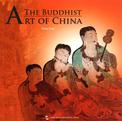中国佛教艺术
出版时间:2011-5 出版社:五洲传播出版社 作者:张总 页数:177 译者:邵达
内容概要
Buddhism originated in ancient India around the sixth-fifth centuries BC. That wasa period of social and religious turmoil, roughly coinciding with the time between theSpring and Autumn Period (770-476 BC) and the Warring States Period (475-221BC) in Chinese history when various schools of thought (like Confucianism, Legalism,Mohism, etc) and their exponents came to the fore. Religiously, Brahmanism had nolonger met the needs of the society, and new Shramanic sects emerged. Politically, therewere 16 kingdoms contending for hegemony in the Ganges-Yamuna river basin, andin the end Magadha rose to prominence under a number of dynasties, peaking with theMaurya Dynasty that unified most of the Indian subcontinent in the middle of the thirdcentury BC.. The history of Indian Buddhism may be divided into four phases: PrimevalBuddhism, Sectarian (Theravada or "Hinayana") Buddhism, Mahayana Buddhism,and Tantric Buddhism. After a long time of evolution, it eventually developed into acolossal, all-embracing religious system represented by a vast collection of scrolls ofBuddhist scripture, which is fundamentally different from Judaism, Christianity andIslamism all based on one sacred book.
书籍目录
IntroductionChapter One Theravada ArtSection One: Cave Temples and Stupas in XinjiangSection Two: Monasteries and Stupas in YunnanChapter Two Mahayana ArtSection One: Han-Jin Period: First Transmission into ChinaSection Two: Buddhist PagodasSection Three: Stone PillarsSection Four: Shrines for Buddhist RelicsSection Five: Temple BuildingsSection Six: Cave TemplesSection Seven: Stone or Gilded Bronze Statues of Buddha and Steles with ShrinesSection Eight: Monasteries in Sacred MountainsSection Nine: Scriptures and Ritual ImplementsSection Ten: Paintings of Buddhist Subjects by Professional Painters, Scholars and OfficialsChapter Three Tantric ArtSection One: Monasteries and Stupas of Tibetan BuddhismSection Two: Combination of Hart and Tibetan ElementsSection Three: Cave Sculptures and Paintings of Tibetan BuddhismSection Four: ThangkasSection Five: Scriptures and Ritual Objects of Tibetan BuddhismSection Six: Rare Chinese Tantric Relics
章节摘录
Theravada sutras written in Pali language spread southward to Sri Lanka, Thailand,Burma and Indonesia. Mahayana sutras spread northward to Central Asia, China, Koreaand Japan; these Sanskrit scriptures were first translated into Central Asian languages,and then into Chinese. The Chinese Tripitaka is the most complete collection of extantBuddhist scriptures; its influence reached beyond China to Korea and Japan. During theseventh century AD Buddhism spread from India to Tibet. As sutras were systematicallytranslated into the local language, Tibetan Buddhism came into being gradually. The relics of Buddhism at different stages (except for Primeval Buddhism) have allbeen found in China. The Theravada Tripitaka scriptures (from Pali, meaning "threebaskets") spread to the region in southwest China's Yunnan Province inhabited by theTai people, and had been translated into the ancient Tai language. The Sarvastivadinschool of Theravada Buddhism spread to the northwestern Xinjiang, leading to thecutting of the Kizil Thousand-Buddha Grottoes from the fourth to the tenth centuryin the ancient state of Kucha (located near present Kuche and Baicheng). The ruinspreserved in Yunnan and Xinjiang, though not very notable, reflect the spread ofTheravada Buddhism in China.
图书封面
评论、评分、阅读与下载
